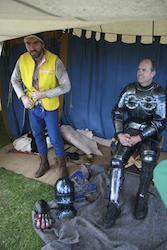|
.jpg) .jpg) .jpg)
.jpg)
.jpg)
.jpg)
.jpg)
Knight is the
English term for a social position originating in the
Middle
Ages. In the
Commonwealth of Nations, knighthood is a non-heritable form of
gentry.
Elsewhere, the
Spanish Caballero (related to "chivalry"),
the
Italian Cavaliere, the
German Ritter (related to the English word "Rider" and the
Swedish word Riddare), or the
Polish Kawaler (for Modern Era knighthoods or Rycerz for
medieval knighthoods) are commonly used in Continental Europe. Outside the
British Commonwealth, the title is respected but may carry less significance,
and thus may or may not appear, for example, in the mass media and other
publications. There are technically differing levels of knighthood (see
Order of the British Empire), but in practice these are even more symbolic
than the title itself today and thus only express the greatness of the
recipient's achievements in the eyes of
the Crown.
The
British legend
of King
Arthur, popularised throughout
Europe in the
Middle
Ages by
Geoffrey of Monmouth in his
Historia Regum Britanniae ("History
of the Kings of Britain") written in the 1130s, and Sir
Thomas Malory's
Le Morte d'Arthur (The Death of Arthur) written in 1485, were
important in defining the
ideal of
chivalry
which is essential to the European
ideal of the
knight as an elite
warrior sworn
to uphold the values of
faith,
loyalty,
courage and
honour such as
Knights Templar. Also the (Spanish) legend Rodrigo Diaz de Vivar known as El
Cid who was a famous Spanish knight who fought to bring Christianity back to
Spain. In a parallel development in
Japan,
Bushidō ("Way
of the Warrior") written down between the 9th and 12th centuries and
Heike monogatari ("Tale
of the Heike") popularised by
Kakuichi in 1371, defined the ideal of the
Samurai
warrior.

.jpg)
.jpg)
.jpg)
.jpg)
.jpg)
.jpg)
.jpg)
.jpg) .jpg)
.jpg)
.jpg) .jpg)
.jpg) .jpg)
.jpg)
.jpg)
.jpg)
.jpg)
.jpg)
.jpg)
.jpg)
.jpg)
.jpg)
.jpg)
.jpg)
.jpg)
.jpg)
.jpg)
.jpg)
.jpg)
.jpg)
.jpg)
.jpg)
.jpg)
.jpg)
.jpg)
.jpg)
.jpg)
.jpg)
.jpg)
.jpg)
.jpg)
.jpg)
.jpg)
.jpg)
.jpg)
.jpg)
.jpg)
.jpg)
.jpg)
.jpg)
.jpg)
.jpg)
.jpg)
.jpg)
.jpg)
.jpg)
.jpg)
.jpg)
.jpg)
.jpg)
.jpg)
.jpg)
.jpg)
.jpg)
.jpg)
.jpg)
.jpg)
.jpg)
.jpg)
.jpg)
.jpg) .jpg) .jpg)
.jpg) .jpg) .jpg)
.jpg)
.jpg)
.jpg)
.jpg)
.jpg)
.jpg)
.jpg)
.jpg)
.jpg)
.jpg)
.jpg) .jpg)
.jpg) .jpg) .jpg) .jpg) .jpg)
.jpg)
.jpg)
.jpg)
.jpg)
.jpg)
.jpg) .jpg) .jpg)
The Middle Ages form the middle period in a traditional schematic division of
European history into three "ages": the classical civilization of Antiquity, the
Middle Ages and Modern Times. The idea of such a periodisation is attributed to
Flavio Biondo, an Italian Renaissance humanist historian.
The Middle Ages are commonly dated from the fall of the Western Roman Empire (or
by some scholars, before that) in the 5th century to the beginning of the Early
Modern Period in the 16th century, marked by the rise of nation-states, the
division of Western Christianity in the Reformation, the rise of humanism in the
Italian Renaissance, and the beginnings of European overseas expansion which
allowed for the Columbian Exchange. There is some variation in the dating of the
edges of these periods which is due mainly to differences in specialization and
focus of individual scholars. Commonly seen periodisation ranges span the years
ca. 400–476 AD (the sackings of Rome by the Visigoths to the deposing of Romulus
Augustus) to ca. 1453–1517 (the Fall of Constantinople to the Protestant
Reformation begun with Martin Luther's Ninety-Five Theses). Dates are
approximate, and are based upon nuanced arguments; for other dating schemes and
the reasoning behind them, see "periodisation issues", below.
The Middle Ages witnessed the first sustained urbanization of northern and
western Europe. Many modern European states owe their origins to events
unfolding in the Middle Ages; present European political boundaries are, in many
regards, the result of the military and dynastic achievements during this
tumultuous period.
.jpg) |